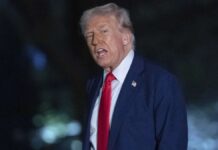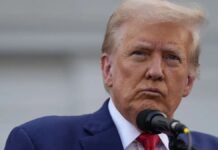The Federal Reserve ignores Trump’s public request to cut interest rates.. Will Trump’s pursuit of “Powell” be repeated?
I stay Federal Reserve The U.S. central bank left interest rates unchanged on Wednesday, as strong inflation expectations and uncertainty over the implications of President Donald Trump’s agenda added to uncertainty over future monetary policy decisions.
The decision of the Federal Open Market Committee (FOMC), which is responsible for determining Interest rates, keeping the target range for the benchmark interest rate steady between 4.25% and 4.50%.
The Federal Reserve had cut interest rates by a total of 100 basis points during the previous three meetings.
Reasons for the US Federal Reserve to fix interest rates
The Federal Open Market Committee explained, in a statement, that its decision to hold the interest rate steady came because inflation remains “somewhat elevated,” while “the unemployment rate has stabilized at a low level in recent months.”
Federal Reserve officials have indicated in recent months that they intend to slow the pace of rate cuts. Interest rates, given the strength of the labor market and inflation remaining above the target level of 2%.
US Federal Reserve’s Expectations for Rate Cuts in 2025
The latest economic forecasts from the Federal Reserve, released at its last meeting, showed that it is expected to cut interest rates by only a quarter point this year, which is half the cut they expected last September.
Powell won’t comment on Trump’s remarks
Federal Reserve Chairman Jerome Powell said he had “no contact” with Donald Trump, since the president said last week that he would “demand a rate cut immediately.”
“I will not provide any response or comment on what the president said,” Powell added at his press conference on Wednesday.
“It’s not appropriate for me to do that,” he continued.
Powell conditions inflation reduction for interest rate cut
“The public should be confident that we will continue to do our job as we always have, focusing on using our tools to achieve our goals,” Powell said.
He added: “We need tangible progress in our battle with inflation before cutting interest rates.”
He pointed out that economic activity continues to expand at a good pace, saying: “The Fed does not need to rush to adjust the stance of monetary policy.”
Caution is a priority as inflation returns
With core inflation at 2.9%, some Fed officials have called for a more cautious approach to cutting interest rates, while others have indicated they are prepared to continue supporting the easing of monetary policy.
The Fed’s preferred measure of inflation is due out next Friday.
Part of the reason for the continued inflationary pressures is the strength of the US economy, which is supported by strong consumer spending.
US GDP data for the fourth quarter of last year is also due on Thursday, with the Atlanta Federal Reserve estimating that the economy grew by 3.2% in the last three months of 2024.
But the Fed’s first meeting of the year is taking place amid uncertainty, largely due to the policies of former President Donald Trump, which could further complicate monetary policy decisions, according to the Financial Times.
Trump’s pursuit of Powell…a recurring scenario
In a repeat of his first-term criticism of Federal Reserve Chairman Jerome Powell, former President Donald Trump last week called on the U.S. central bank to immediately cut interest rates.
However, the US President has no direct authority over the Fed’s decisions.
One of the most opaque aspects of Trump’s policies is his trade approach, as he has pledged to impose tariffs on Mexico and Canada by next month, along with imposing tougher tariffs on China, and he is still dangling the possibility of imposing comprehensive tariffs globally.
This approach has prompted some Federal Reserve officials to raise their inflation forecasts for this year, given the potential inflationary effects of Trump’s trade policies.
Others, however, argue that they can “watch” the impact of tariffs, arguing that they may not lead to fundamental changes.
In any case, the US Federal Reserve expects that it will take longer to reduce inflation to the target level, which may lead to a slower pace of interest rate cuts.
Market expectations indicate that the US Federal Reserve may not start cutting interest rates again before next June, according to data from the CME Group.
The Federal Reserve is scheduled to hold 7 regular meetings during 2025, with the next meeting to be held on March 19.











